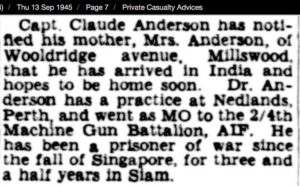The Soldier's Details

- Surname:
- Anderson
- First Name:
- Claude Leonard
- Nick Name:
- Pills or Doc
- Rank:
- Captain (R.M.O.)
- Regimental #:
- WX3464
- Awards:
- Mentioned in Despatches
- Company:
- Attached 2/4th A.A.M.C., Battalion Headquarters
- Enlisted:
- 2.12.1940
- Discharged:
- 4.01.1946
- DOB:
- 26.12.1909
- Place of Birth:
- Curramulka, South Australia
- Father's Name:
- Ernest James Anderson
- Mothers's Name:
- Edith Alice Anderson
- Religion:
- Methodist
- Pre-war Occupation:
- General Practitioner
- Singapore:
- Selarang Camp Changi
- Force:
- ‘A’ Force Burma, Green Force, No. 3 Battalion.
- Camps Thailand:
- Tamarkan, Lopburi
- Camps Burma:
- Victoria Point, Khonkan 55km (1.9.1943-19.10.1943)
- Return Details 1945:
- Bangkok-Singapore by aircraft, Singapore-Fremantle, HMT Moreton Bay.
General Description
Anderson although wounded in the hand at Jurong Road, Singapore on 10 Feb 1942, he remained on duty.
From Singapore, Claude Anderson left Singapore to sail to the south west coast of Burma and then to Burma-Thai Railway with 3,000 Australians with ‘A’ Force Burma, Green Force No. 3 Battalion.
Green force arrived first at Victoria Point where the POWs were to work at the wharves or repairing the aerodrome.
Claude Anderson assisted Albert Coates with about 60 amputations, some of which were men of the 2/4th.
‘The Japanese sent trained Surgeon Dr. Albert Coates from 105 kilo to 55 kilo camp, Kohn Kuhn to establish a 1800 bed hospital camp for men up the line who were too sick to work.
Coates was very ill a the time with scrub-typhus and had to be assisted to stand.
Bamboo huts were constructed. A small operating theatre was built to the side furnished with a bamboo table for surgery. The floors were dirt and the roof made of thatched palm.
There was no equipment, supplies nor beds. With no proper instruments Coates and his team improvised with a few artery forceps, scalpels and sharpened table knives for amputations. They used bent forks for retractors, a kitchen saw and darning needles. The Japanese jokingly gave them a curette. Coates had a spinal needle which he used to give anaesthetics. There was no general anaesthesia for small procedures such as small amputations (toes) nor cleaning of ulcers (3 men would hold down the patient to clean the wound with spoon, knife, etc).
As soon as Coates was sufficiently well he commenced work; performing a wide range of surgery including tracheostomy for diphtheria, ileostomy for toxic amoebic dysentery, strangulated hernia reduction and complications of the ever present tropical ulcer. Coates performed 120 amputations for gangrenous lower limbs and sometimes more than 50 men a day would have ulcers curetted.
Dr John Gibbon was initially the only doctor to assisting Coates until Claude Anderson arrived. Claude Anderson assisted with 60 amputations.’
Claude was recovered from Nakhon Nayok when Japan surrendered in 1945.
Claude Anderson – ‘The Man’
Claude Leonard Anderson was born 26/12/1909 at Curramulka on the Yorke Peninsula, South Australia. He was schooled at Prince Alfred College before taking up 6 years medical training at Adelaide University. On graduation he attained a position at Royal Perth Hospital. After 27 months at Royal Perth, Claude was appointed 2nd in-charge.
When the second Word War erupted in 1939 Claude was a practicing GP with his own rooms in Nedlands. He decided to enlist with the 2nd AIF where he was acting as Medical Officer at Northam Camp Recruit Training Depot. It was at Northam where Claude accepted the position of Regimental Medical Officer with 2/4th MG Battalion. He moved to No. 2 Camp Northam where the Battalion was being formed by Lieutenant-Colonel M.J. Anketell. If asked to describe himself, Claude would probably have said he was just an ordinary bloke. But in reality Claude could have been described as a quiet, softly spoken man, a true gentleman in every sense of the word.
He just got on and did the job without complaint. His services during the action on Singapore Island and of course as POW Medico were recognised by his being Mentioned in Despatches. Beyond reward however, Claude never failed to command the respect and admiration from all who served with this battalion.
“A few words about tropical ulcers and Col. Coates. He realized that they were all progressive, and as we did not have any effective treatment, all would lead to death. He thought lower third thigh amputations might be useful. A Dutch chemist, Capt.van Boxtel from Java, had a bottle of iodine and a large number of cocaine tablets. He was able to make up a solution which worked as a spinal anaesthetic. Amazingly, Col Coates had .a needle for spinal injections. When I arrived at the hospital they were ready to start the amputations and Col. Coates asked me to assist him. In the next six weeks, before I went back to my job on the railway line, he amputated about 60 legs. The scheme worked fairly well” (although many still died). “Occasionally the Japs killed a yak for the POW. Col Coates arranged to be notified of the yak killings, and he removed strips from the outer surface of intestines. These strips, about the diameter of a thin piece of knitting wool, were then washed and placed in a bottle of iodine, where after 7 days they were thought suitable for use as catgut. I thought this was a brilliant project”.
Claude had a number of men who assisted him as medical orderlies. They included Bob Ritchie (Kojonup), Danny Bevis (Kalgoorlie) and Eric Baker. Ritchie was awarded the BEM. From Claude Anderson’s interview with Winstanley.
Follow the link below to read Peter Winstanley’s article on Captain Claude L Anderson WX3464 Medical Officer 2/4 Machine Gun Battalion
Claude Anderson’s Appointment was terminated 4/1/1946.
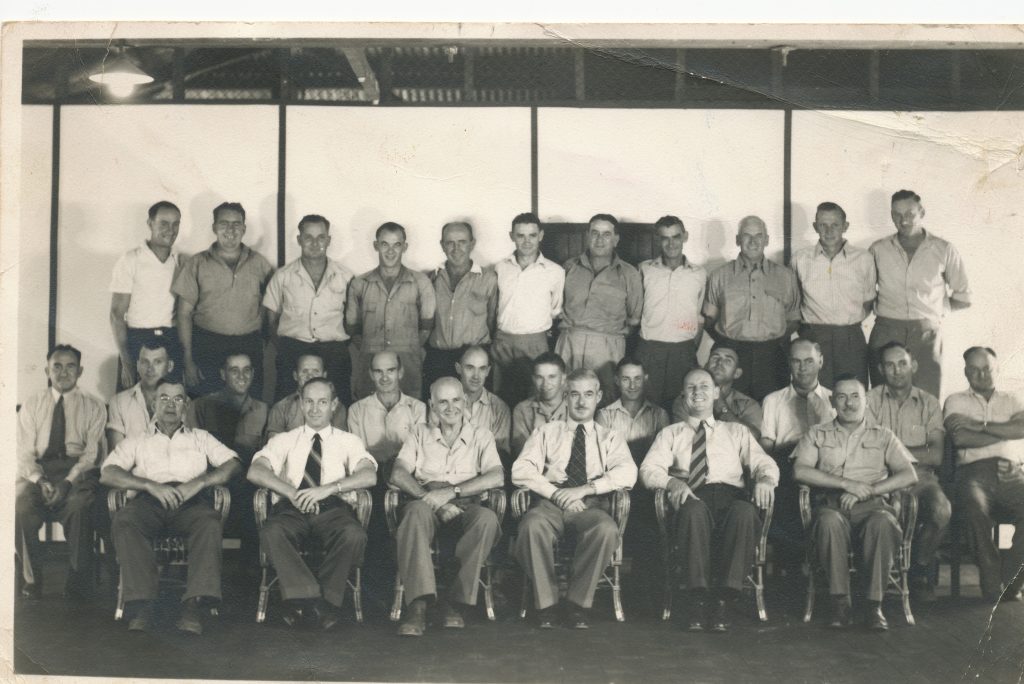
At the end of the war Claude landed in Adelaide 5 Nov 1945 intent on meeting up with his ‘girlfriend’ from whom he had not heard a word from during the entire war.
He tells the story when they did meet, she said they were to be married the following day!
Travelling about was very difficult at that time, so it was not until New Years Eve that Claude was able to fly into Perth. His wife travelled a few days later.


View Peter Winstanley’s video interview of Claude Anderson WX3464.
Also read Captain Claude Anderson.
Read further about Claude Anderson & Albert Coates
Below: Archie Thomas mentioned Claude in his card home – POWs would write names of mates believing if their card arrived, his family would notify the other men’s families.
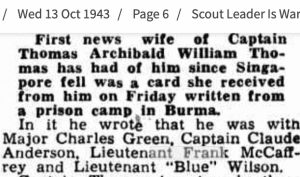
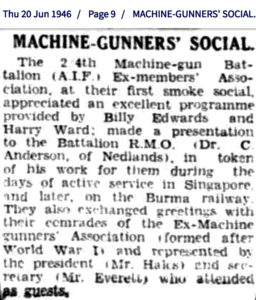
Listen to interview IWM with Claude
Below: The former POWs established the 2/4th MGB ex-Members Assoc. earlier in 1946.

Below: Printed in RSL’s Listening Post – August 2003
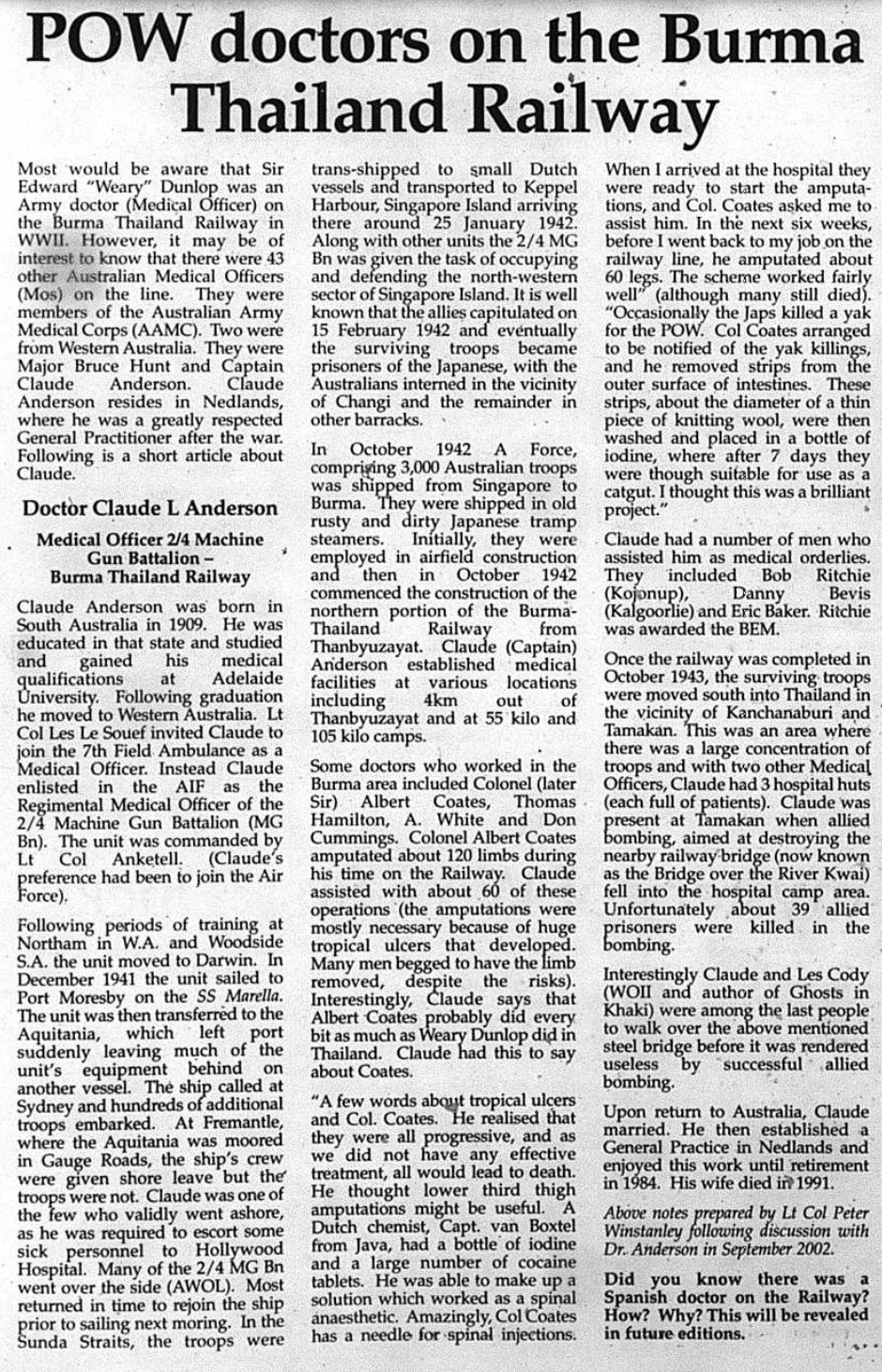
Claude died in 2008.
Camp Locations:
- Selarang Camp Changi - Singapore
- Lopburi - Thailand
- Tamarkan, Tha Makham 56k - Thailand
- Khonkan, 55Kilo Hospital 360k - Burma
- Victoria Point, Kawthoung - Burma. \'A\' Force, Green Force No. 3 Btn

